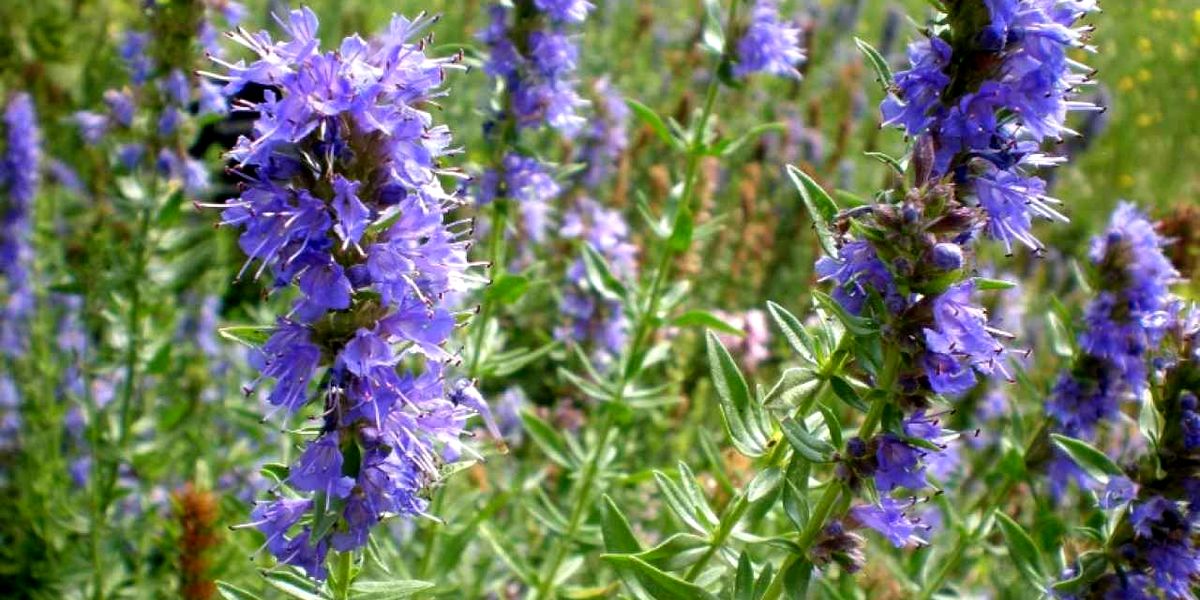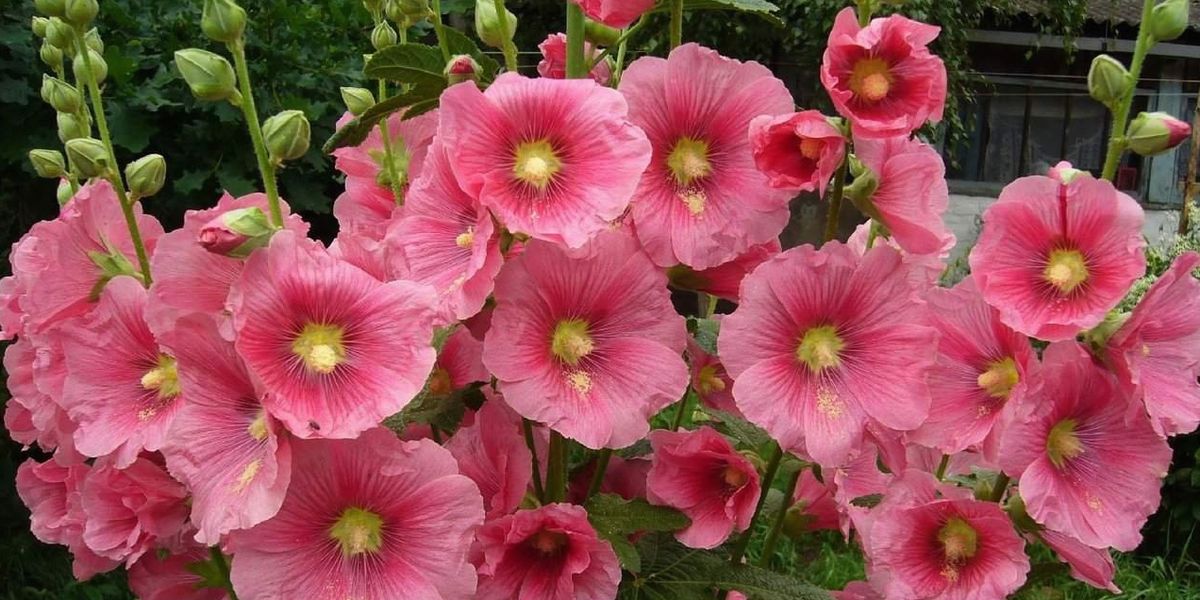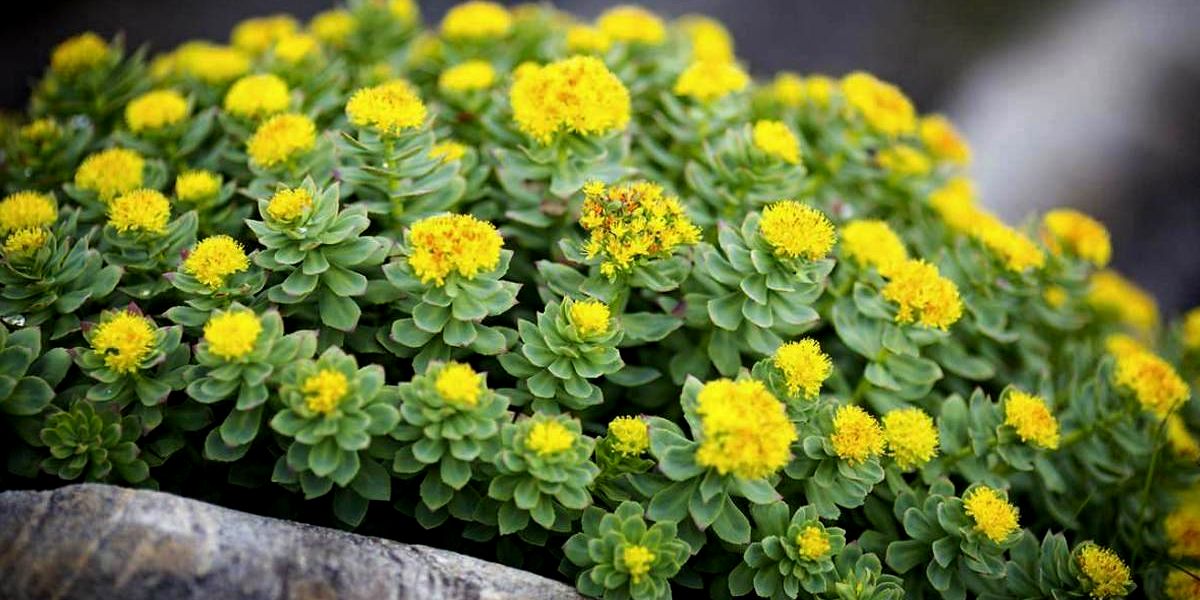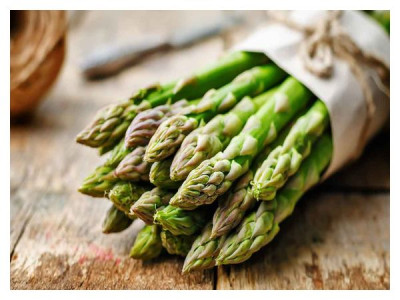To make the flower garden not only beautiful, but also useful, plant medicinal plants. We have compiled a selection of crops that will delight you with their decorative properties and at the same time do not require special care. All you have to do is choose plants based on their healing properties and personal preferences.
Caring for a flower bed with medicinal plants is no more difficult than caring for flower plantings. Plants will need your usual actions - weeding, loosening, and in drought - watering. It is advisable to cut off fading inflorescences to prolong flowering. Otherwise, the medicinal flowerbed will not cause much trouble for summer residents. What crops are suitable for a medicinal flower bed? Look in our selection.
Marshmallow (Althaea officinalis)

A perennial plant with an erect stem belongs to the Malvaceae family, reaching a height of 60-150 cm. It blooms from July to September, the peak of flowering occurs in the second or third year after planting. It is not difficult to grow marshmallows in your garden. The main thing is that the soil is sufficiently fertile. In folk medicine, the plant is used for acute respiratory diseases, cough, whooping cough, pneumonia, bronchitis. Marshmallow also helps with stomach and duodenal ulcers, inflammation of the bladder and intestines, kidney diseases, and skin diseases. Marshmallow roots are harvested at the beginning of the growing season, before the above-ground part grows (March-May), as well as in the fall, when the stems begin to dry out.
Bergenia crassifolia

This herbaceous perennial does not lose its decorative effect from spring until late autumn. At first, small flowers on a high peduncle make the plant attractive, and then large shiny leaves become the decoration of the garden, which by autumn change color from green to red. The plant feels great both in the sun and in the shade, but in the first case, in hot weather, the bergenia will have to be watered regularly. Its leaves and roots are used to treat gastrointestinal diseases, tuberculosis, pneumonia, rheumatism, women's diseases and urinary tract diseases. Raw materials are harvested in June-July.
Sandy immortelle (Helichrysum arenarium)

From May to October, immortelle, or helychrysum, delights with bright colors in the flowerbed, and later, thanks to its unfading flowers, the plant is used in winter bouquets. The culture is quite unpretentious and does not require special care, but it will become indispensable when filling an alpine hill. The flower is used for diseases of the liver, gastrointestinal tract, and kidneys. Used as a diuretic and hemostatic agent. Raw materials are harvested in June.
Elecampane (Inula helenium)

A large perennial plant up to 2 m high, it is also called wild sunflower. Growing elecampane is not difficult - the crop loves well-moistened soil, although it tolerates drought quite steadfastly. The plant is also resistant to diseases, pests and is not afraid of cold weather, which means it does not need to be covered for the winter.
Elecampane is used as an expectorant for diseases of the upper respiratory tract, in the treatment of diseases of the stomach and duodenum, for chronic enteritis, colitis, for eczema, trophic ulcers, and atopic dermatitis. Helps with women's ailments, migraines, diabetes, tachycardia. Rhizomes and roots of elecampane are used as medicinal raw materials; they are harvested in September-November.
Oregano (Origanum vulgare)

The plant not only blooms beautifully, but also attracts pollinating insects to the garden with its pleasant smell. Oregano is planted in sunny places; in the shade the stem will stretch and the foliage will be less fragrant. The plant does not like stagnant moisture, as well as excessively dry areas. Oregano is used as an expectorant and diaphoretic for colds, inflammatory diseases of the throat, to improve appetite and digestion, and for gastrointestinal diseases. Has a calming and mild hypnotic effect. Raw materials are harvested at the beginning of mass flowering, in July.
St. John's wort (Hypericum perforatum)

A useful plant with small yellow flowers is not at all difficult to grow in your dacha. For St. John's wort, a sunny area with good protection from cold winds is allocated. In the shade, the crop will grow much slower. The emerging shoots will require careful weeding, but in the future the plant will not cause any trouble in caring for it. St. John's wort is used to treat bruises, wounds, ulcers, abscesses, and burns. It is also used internally to treat the stomach, intestines and gall bladder, and is used for respiratory diseases and nervous disorders. Medicinal raw materials are harvested during the flowering phase, before the appearance of unripe fruits, in June-August. When harvesting, cut off the tops of the plant 25-30 cm long.
Hyssop (Hyssopus officinalis)

A perennial with large paniculate inflorescences blooms almost all summer, from June to September. Hyssop will not only decorate a medicinal flower bed, but will also attract pollinators to the garden. Prefers sunny places with well-drained soil. Afraid of moisture stagnation and damping off. There is no need to cover it for the winter. Hyssop is actively used in folk medicine as an expectorant for chronic diseases of the upper respiratory tract (bronchitis, tracheitis, laryngitis), bronchial asthma, as well as in the treatment of gastrointestinal diseases and as a wound healing agent. For medicinal purposes, the tops of flowering shoots with leaves are collected, the grass is cut at the beginning of flowering, in late June - early July.
Calendula (Calendula officinalis)

An herbaceous annual with yellow-orange flowers, it does not require any special growing conditions or much effort in care. In addition to their bright and colorful blooms, marigolds help with a variety of ailments. The inflorescences are used for gastrointestinal diseases, as well as for influenza, bronchitis and other respiratory ailments. Decoctions help with problems with the gallbladder and liver, reduce blood pressure, have a beneficial effect on the nervous system, and help cope with insomnia, increased excitability, depression, and tachycardia. The plant has anti-inflammatory, wound-healing and antiseptic effects, treats skin diseases. The collection of flower baskets begins during the period of mass flowering, from June to August.
Lavender (Lavandula)

A delicate subshrub will not only give the garden a special charm and attractiveness, but will also attract bees and other pollinators to the site, and will also help cope with a large number of ailments. Lavender loves sunny places and light neutral soil, needs infrequent watering and does not tolerate stagnation of moisture. The plant must be pruned and covered for the winter.
Lavender has strong antimicrobial properties; colds are treated with a decoction of flowering branches. Lotions and compresses are effective for migraines and headaches. Lavender will help cope with neuroses, insomnia, general weakness, neurasthenia, some skin diseases, neuralgia and rheumatism. The upper part of the stems with inflorescences is harvested for raw materials during the flowering period.
Stockrose (Alcea)

A plant on tall stems does not need special care, but it will delight you with long flowering - from early summer until late autumn. When choosing a planting location, give preference to sunny, lightly shaded areas without drafts. Strong winds can break tall stems. A great option is to plant hollyhocks near a wall or fence.
In folk medicine, the plant is used for diseases of the upper respiratory tract, gastritis, hemorrhoids, pancreatitis, skin diseases, and as a treatment for wounds. Flowers are collected both as individual petals and as whole buds throughout the flowering period. In autumn, medicinal rhizomes are dug up.
Monarda

The «shaggy» flower is also called bee balm or wild bergamot. Monarda loves sunny areas, is not picky about the soil, but during prolonged drought it needs regular watering. The plant is famous for its bactericidal properties. Used to heal wounds and treat skin diseases. Monarda is used for diseases of the respiratory system, for stomatitis, the plant has a positive effect on the gastrointestinal tract, improves the functioning of the liver and gall bladder, and has a beneficial effect on digestion. The tops of shoots with flowers are used as medicinal raw materials; they are harvested at the beginning of flowering.
Rhodiola rosea

A perennial plant 20-30 cm high with bluish foliage and small flowers looks quite decorative, but in gardens it is often grown as a medicinal crop. The plant is moisture-loving, loves light, loose soil, prefers well-lit places, protected from drafts. Rhodiola normalizes the activity of the central nervous system, relieves fatigue, increases efficiency, strengthens the body's overall resistance, counteracts stress, helps with frequent colds, as well as gastrointestinal disorders. Rhizomes and roots of plants with more than two stems are harvested after the seeds have ripened.
Chamomile (Matricaria chamomilla)

Another useful and no less beautiful flower, which pleases with its long flowering from June to August. Chamomile does not require special care, but it helps with many diseases. The plant is light-loving, responds well to watering, but does not tolerate waterlogging. Has an anti-inflammatory, calming effect. Used for tonsillitis, pharyngitis, sore throat, diseases of the gastrointestinal tract, genitourinary tract, skin diseases, diseases of the liver and biliary tract, as a diaphoretic. Flowers are harvested at the beginning of flowering, when the edge “tongues” are located horizontally or directed upwards.
Common yarrow (Achillea millefolium)

The perennial herbaceous plant is easy to care for and blooms for a long time. Thanks to the variety of varieties, baskets of inflorescences of various colors will fill the garden with bright colors from June to September. In addition to its medicinal properties, yarrow will help repel harmful insects from the area.
In folk medicine, yarrow is used as a hemostatic and anti-inflammatory agent. Used for internal and external bleeding, bleeding wounds, hemorrhoids, as well as for the treatment of diseases of the stomach and intestines, inflammatory processes in the kidneys and urinary tract, kidney stones, and gynecological ailments. Yarrow flowers and leaves are used as medicinal raw materials. Flowers are collected in summer, and leaves are collected in May, immediately after blooming.
Viola tricolor

Violet, or pansy, blooms until autumn and is easy to care for, growing in both sun and partial shade, loving moderate watering and well-drained soil. In regions with frosty and snowless winters, plants need shelter. Violet helps with coughs and other respiratory diseases, gastrointestinal diseases, neuroses, tachycardia, insomnia, arthritis, gout, and skin diseases. A decoction of tricolor violet is a powerful anti-inflammatory and blood purifying agent. Raw materials are harvested during the flowering period.
Common physalis (Phusalis alkekengi)

Bright «lantern» fruits will become an original decoration of the garden in the fall, and in winter the orange «boxes» will look original in a bouquet. Physalis loves sunny areas and moderate watering, prefers light and fertile soil. The plant has antiseptic, analgesic and anti-inflammatory properties, and is used as an effective diuretic, choleretic and hemostatic agent. Helps with nephritis, cystitis, kidney stones, as well as rheumatism and gout.
Physalis fruits are used as raw materials; their harvesting begins in early autumn.
Black cohosh (Actaea racemosa)

The plant is also called black cohosh. The plant emits an unpleasant aroma, but this in no way reduces the popularity of the crop among summer residents due to its valuable medicinal properties. The culture can grow in one place for up to 20 years! Easily adapts to any conditions and does not have strict requirements for soil and lighting. Does not like stagnant moisture.
Rhizomes and roots of cohosh are used for gynecological ailments, colds, arthrosis, osteochondrosis, rheumatism, migraines, headaches and toothaches, neuralgia, insomnia. Raw materials are dug up in the fall after the fruits ripen.
Thyme (Thymus serpyllum)

A creeping plant with many flowers is grown not only to decorate the garden, but also as a useful spice. Thyme is unpretentious, not afraid of drought and frost. Grows well in sunny or minimally shaded areas. The place where thyme grows, also known as thyme, should be protected from drafts.
The plant is used for diseases of the respiratory system, stomach, intestines, bladder, for helminthic infestations and as a diaphoretic and diuretic. Thyme has a disinfectant, antispasmodic, wound healing, expectorant, sedative effect, and also improves memory, relieves stress, and helps with fatigue. Thyme grass is harvested during the flowering phase, cutting off the upper parts of leafy shoots, without coarse woody stems.
Salvia officinalis

The culture is not only highly decorative, but also perfectly attracts pollinating insects to the site; sage is also used in cooking. Sage is a fairly unpretentious plant, it loves light and regular watering, grows on any soil, and does not tolerate excess moisture. For the winter it needs shelter.
Sage helps with sore throat, bronchial asthma, cough, and copes with sore throat, stomatitis, and gingivitis. The plant is used for urolithiasis, gastric and duodenal ulcers, gastritis, liver and gallbladder diseases, as well as atherosclerosis, polyarthritis and radiculitis. Sage is also used to treat gynecological diseases, diabetes, tuberculosis, and skin diseases. Taking the decoction helps improve blood circulation, has a calming effect on the nervous system, and improves memory. The tops of young shoots, as well as leaves at the beginning of flowering, are collected as medicinal raw materials.
Echinacea purpurea

A bright flower with a convex core and drooping purple petals is eye-catching when in bloom and is easy to care for. In addition, this crop is an excellent honey plant. Sunny places are allocated for planting; partial shade will negatively affect flowering. Echinacea does not tolerate stagnant moisture. In cold, snowless winters it needs shelter.
The plant has many beneficial properties - it is considered an excellent immunostimulating, restorative, antiviral and anti-inflammatory agent. Echinacea can relieve pain, heal wounds, burns, abscesses, treat colds, flu, diseases of the genitourinary system, increase potency, normalize blood pressure and heart function. Leaves, flowers and rhizomes with roots are used as medicinal raw materials. Leaves and flowers are collected during flowering, and rhizomes with roots - in early spring or late autumn.
Creating a medicinal flowerbed on a site is not at all difficult. Choose the plants you like, enjoy their beauty and improve your health at the same time!









